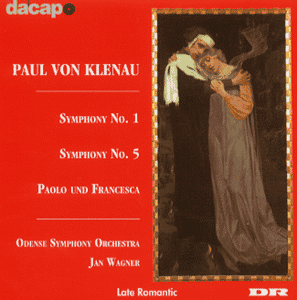Paul von KLENAU
Symphony No. 1 in F minor
Symphony No. 5(Triptikon)
Paulo und
Francesca
 Odense Symphony Orchestra
- Jan Wagner
Odense Symphony Orchestra
- Jan Wagner
recorded in the Odense Concert Hall - 17-20/5/99- in association with Danish
Radio.
 DaCapo 8.224134 [69.08]
DDD
DaCapo 8.224134 [69.08]
DDD
Crotchet
Amazon
UK

Paul von Klenau born in 1883 - 1946, is a relatively unknown Danish composer
who spent most of his active composing life in Germany, not returning to
Denmark until 1940. He was educated in Copenhagen, but left immediately after
two years study at the Royal Academy of Music in Copenhagen. He studied in
Berlin with Max Bruch, and in Munich with Ludwig Thuille and later with Max
Schillings.
Given his background you can probably imagine what these works sound like
before even hearing them - Bruckner like sonorities with a firm grasp of
orchestration although with a restricted ability for writing distinctive
melodies. The orchestra is the full Bruckner orchestra, including eight horns,
organ, four tubas 2 harps and bass drum.
The first symphony displays the influence of Beethoven and Bruckner and was
first performed in Munich in 1908. It is written in five movements the first
being a very short introduction to the work, lasting only three minutes,
acting as the introduction to the second section. After this introduction,
the second movement proper gets under way with surging themes, albeit a little
obtuse thematically, but impressive nevertheless. We then have a very expressive
adagio, in the style of Bruckner, followed by a scherzo and capped off with
an allegro which develops into a hugely triumphant finale, which is supplemented
by the organ.
The fifth symphony is a much later work, written in 1939, about the time
Klenau returned to live in Denmark, and was one of three symphonies written
at that time. He had returned to symphonic writing after having had written
seven operas in the intervening twenty years in Germany.
These later symphonies were more concise and tighter harmonically, and reflecting
the influences of other European composers, notably Wagner and early Berg
and Schoenberg. These influences were no doubt strong because the composer
was at the time enjoying an extremely active career as a conductor, and he
had made a speciality of such works as Schoenberg's "Gurrelieder", Debussy's
"Pelleas et Melisande" and Richard Strauss's early orchestral works.
The fifth is in three movements fast, slow, faster, and will repay repeated
hearings. The writing and orchestration is tighter and the symphony lasts
less than a third of the time of the first, and does not sag quite as much
as the earlier work.
Paulo und Francesca was a popular tale to set to music at the turn of the
century, and although you won't find a Tchaikovsky masterpiece here, the
symphonic fantaisie is well worth a listen. Unlike Tchaikovsky's fantasy,
rather than end the work with a return to the swirling storms of Dante's
Hell, the piece ends with a representation of the sorrow of Dante over the
fate of the two lovers.
As far as I can tell, the performances are first class, with a clear and
forthright recording quality plus a good set of multi-lingual notes - well
worth buying and enjoying.
John Phillips

